What do you think?
Rate this book


Paperback
First published January 1, 1999
This did not make for uninteresting reading, although Bringhurst does at times drift into polemics; however, it did rather undermine my attempt to actually acquire my own understanding of Haida stories and thought. A Story as Sharp as a Knife is closer to Landscape and Memory than it is to Dine Bahane. Despite Bringhurst repeatedly bragging of the fine work Swanton did at the turn of the twentieth century in recording faithfully some 800 pages of Haida myths, including complete epics, he only provides the reader with snippets framed by the paraphrases he must laments from other translators, and analysis or contemporary history of the transcription processing running many times the excerpts’ lengths.
At least his digressions are interesting (for the most part), and they prompted me to think more deeply about the nature of myth and storytelling, and to ponder again the complexities of translation and language, especially with regards to oral literature. I do not agree with all, perhaps even many, of his conclusions, but that is rather beside the point, which is engagement with the ideas. Disagreement in this case does not arise from any lack of thorough and critical thinking by the author. The problem is that the book does not present any single Haida story in full enough form, without interruption, for the reader to properly appreciate or understand it on its own merits, which is frustrating in itself, and more so for that being my main goal in continuing to seek these sorts of works. That frustration is exacerbated when the barrier to engaging with the stories comes in the guise of the author – for Bringhurst is serving more as author here than he is as translator – not trusting the reader to understand the myth without assistance.
Although he clearly has knowledge of ancient literature from other regions, Bringhurst insists on maintaining that the oral tradition of the Haida and other American peoples is somehow not analogous to mythical traditions, oral or otherwise, in other parts of the world, which does not align with my impressions from the fragments presented in A Story as Sharp as a Knife and my own reading of other cultures’ stories. War stories and slaves in ancient Haida (and more recent Haida) history are mentioned, but tucked aside in the analyses, suggesting Bringhurst seeks to maintain a certain rose-tinted perspective on the Haida and related peoples, rather than engaging critically with difficult and complex topics. This is just instance of a persistent effort to frame the entire book in terms fundamentally modern, where I’m seeking to engage with the Haida with as little frame as possible.
Therein lies my difficulty in rating and recommending this book. Had I been seeking a Landscape and Memory-like treatment of Haida storytelling, A Story as Sharp as a Knife would be an easy 4 or 4.5 stars, with a hearty recommendation. As a philosophy/art criticism book, it is thought-provoking, eloquent, and thorough. As a translation of Haida stories and mythology, it falls woefully short. Such translations as it does include are of high quality, and I would gladly read more, but they are so broken up and truncated that the larger effect is entirely lost. Bringhurst’s analysis efforts stretch over two more books. While I would gladly read ore of his translations of Haida myths and stories, I do not know that I wish to wade through two more books full of fragmentary flashes of my real goal. Instead, I will pick up (at some point), his actual translations.